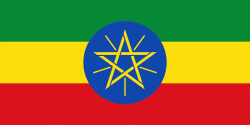Degehabur Zone (Degehabur Zone)
Jarar (Jarar) is a zone in Somali Region of Ethiopia. It was previously known as the Degehabur zone, so named after its largest city, Degehabur. Jarar Zone is bordered on the south by Korahe, on the southwest by Nogob, on the northwest by Fafan Zone, on the southeast by Dollo, and on the northeast by Somaliland.The occupant of this zone are the reer Isaq and Ugaas Samatar ( Malingur) mohamed zuber of Ogaden clan.
Based on the 2007 Census conducted by the Central Statistical Agency of Ethiopia (CSA), this Zone has a total population of 478,168, of whom 268,006 are men and 210,162 women. While 62,584 or 13.01% are urban inhabitants, a further 223,778 or 46.8% were pastoralists. The largest ethnic group reported in Jarar were the Somalis (98.92%); all other ethnic groups made up 1.08% of the population. Somali language is spoken as a first language by 99.62%; the remaining 0.38% spoke all other primary languages reported. 98.72% of the population said they were Muslim.
The 1997 national census reported a total population for this Zone of 304,907 in 72,010 households, of whom 168,211 were men and 136,696 were women; 57,866 or 18.98% of its population were urban dwellers. The largest ethnic group reported in Jarar was the Somalis (99.55%); a similar proportion spoke Somali (99.58%). Only 13,514 or 4.43% were literate.
According to a May 24, 2004 World Bank memorandum, 1% of the inhabitants of Jarar have access to electricity, this zone has a road density of 10.3 kilometers per 1000 square kilometers, the average rural household has 1.5 hectare of land (compared to the national average of 1.01 hectare of land and an average of 2.25 for pastoral Regions) and the equivalent of 1.5 heads of livestock. 28.2% of the population is in non-farm related jobs, compared to the national average of 25% and an average of 28% for pastoral Regions. 23% of all eligible children are enrolled in primary school, and 3% in secondary schools. 100% of the zone is exposed to malaria, and none to Tsetse fly. The memorandum gave this zone a drought risk rating of 614. In 2006, the Jarar zone was affected by deforestation due to charcoal production.
Based on the 2007 Census conducted by the Central Statistical Agency of Ethiopia (CSA), this Zone has a total population of 478,168, of whom 268,006 are men and 210,162 women. While 62,584 or 13.01% are urban inhabitants, a further 223,778 or 46.8% were pastoralists. The largest ethnic group reported in Jarar were the Somalis (98.92%); all other ethnic groups made up 1.08% of the population. Somali language is spoken as a first language by 99.62%; the remaining 0.38% spoke all other primary languages reported. 98.72% of the population said they were Muslim.
The 1997 national census reported a total population for this Zone of 304,907 in 72,010 households, of whom 168,211 were men and 136,696 were women; 57,866 or 18.98% of its population were urban dwellers. The largest ethnic group reported in Jarar was the Somalis (99.55%); a similar proportion spoke Somali (99.58%). Only 13,514 or 4.43% were literate.
According to a May 24, 2004 World Bank memorandum, 1% of the inhabitants of Jarar have access to electricity, this zone has a road density of 10.3 kilometers per 1000 square kilometers, the average rural household has 1.5 hectare of land (compared to the national average of 1.01 hectare of land and an average of 2.25 for pastoral Regions) and the equivalent of 1.5 heads of livestock. 28.2% of the population is in non-farm related jobs, compared to the national average of 25% and an average of 28% for pastoral Regions. 23% of all eligible children are enrolled in primary school, and 3% in secondary schools. 100% of the zone is exposed to malaria, and none to Tsetse fly. The memorandum gave this zone a drought risk rating of 614. In 2006, the Jarar zone was affected by deforestation due to charcoal production.
Map - Degehabur Zone (Degehabur Zone)
Map
Country - Ethiopia
 |
 |
| Flag of Ethiopia | |
Anatomically modern humans emerged from modern-day Ethiopia and set out to the Near East and elsewhere in the Middle Paleolithic period. Southwestern Ethiopia has been proposed as a possible homeland of the Afroasiatic language family. In 980 BCE, the Kingdom of D'mt extended its realm over Eritrea and the northern region of Ethiopia, while the Kingdom of Aksum maintained a unified civilization in the region for 900 years. Christianity was embraced by the kingdom in 330, and Islam arrived by the first Hijra in 615. After the collapse of Aksum in 960, a variety of kingdoms, largely tribal confederations, existed in the land of Ethiopia. The Zagwe dynasty ruled the north-central parts until being overthrown by Yekuno Amlak in 1270, inaugurating the Ethiopian Empire and the Solomonic dynasty, claimed descent from the biblical Solomon and Queen of Sheba under their son Menelik I. By the 14th century, the empire grew in prestige through territorial expansion and fighting against adjacent territories; most notably, the Ethiopian–Adal War (1529–1543) contributed to fragmentation of the empire, which ultimately fell under a decentralization known as Zemene Mesafint in the mid-18th century. Emperor Tewodros II ended Zemene Mesafint at the beginning of his reign in 1855, marking the reunification and modernization of Ethiopia.
Currency / Language
| ISO | Currency | Symbol | Significant figures |
|---|---|---|---|
| ETB | Ethiopian birr | Br | 2 |
| ISO | Language |
|---|---|
| AM | Amharic language |
| EN | English language |
| OM | Oromo language |
| SO | Somali language |
| TI | Tigrinya language |















